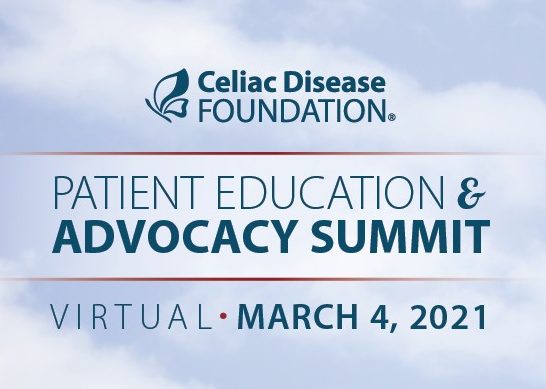Summary of the 2021 Patient Education & Advocacy Summit
By Van Waffle
For the second consecutive year, the Celiac Disease Foundation hosted the Patient Education & Advocacy Summit, with a primary goal of training a new cadre of Celiac Disease Foundation State Advocacy Ambassadors to engage patients and legislators from their communities in the struggle to accelerate research for treatments and a cure. The Summit was made possible by an engagement award from the Patient Centered Outcomes Research Institute, known as PCORI. Celiac Disease Foundation CEO, Marilyn Geller, said, “Celiac disease afflicts millions of Americans, most of whom are undiagnosed, and is second only to end-stage renal disease in perceived burden by patients and caregivers. Despite these appalling facts, the federal government has never been a major funder of celiac disease research. As a direct consequence, celiac disease is the most prevalent autoimmune disease with no FDA-approved treatments.”
The March 4 Summit began with an announcement of the new Celiac Disease Caucus by Rep. Steve Stivers (R-OH), who will co-chair with Rep. Betty McCollum (D-MN). This bipartisan Caucus will allow Members of Congress with a common interest in celiac disease to share information, raise awareness among other members, and advocate the concerns of patients. The formation of this Caucus is a tremendous step forward in fulfilling the mission of the Celiac Disease Foundation.
The Summit equipped the community to promote legislation benefiting people with celiac disease. Initiatives needing support include: federal funding for biomedical research, implementation of gluten-free labeling guidelines for prescription medicines, and Medicare coverage of dietitian visits for the newly diagnosed, as well as those struggling with the gluten-free diet. With more than 1,700 attendees, the Summit featured multiple sessions on celiac disease education and advocacy, led by leading celiac disease researchers and drug developers, congressional representatives, celiac disease trial participants, and patient advocates.
Current State of Celiac Disease Diagnosis, Treatment, and Clinical Research
One of the most puzzling questions about celiac disease is: why is it becoming more common? Edwin Liu, MD, Director of the Colorado Center for Celiac Disease, Aurora, suggested some possibilities, but essentially the answer remains unknown. Large population studies are necessary, such as The Environmental Determinants of Diabetes in the Young (TEDDY), which also collects data on celiac disease. There is no single factor that causes celiac disease. However, the most significant ones are: genetics, family history, being female, country of birth, early diet (new data suggests introducing moderate amounts of gluten with solid food may reduce a child’s risk of developing celiac disease later), and early childhood gastrointestinal infections.
Cross-contact with gluten is inevitable, with one study showing two-thirds of patients experiencing accidental gluten exposure in a 10-day period.
Benjamin Lebwohl, MD, Director of Clinical Research, Celiac Disease Center, Columbia University, New York, presented the newest approaches to diagnosing celiac disease. Fewer patients are presenting with classic symptoms; patients are more commonly presenting with other health concerns, such as: low iron, constipation, irritable bowel syndrome, poor dental enamel, neurological symptoms, short stature, elevated liver enzymes, infertility, brittle bones, delayed puberty, and fatigue. It has become vital for physicians to know these signs and consider testing for celiac disease in the absence of other causes. Many patients are misdiagnosed, or their diagnosis is delayed because their physician does not associate these problems with celiac disease.
Jocelyn Silvester, MD, PhD, Harvard Celiac Research Program, and Pediatric Gastroenterologist, Boston Children’s Hospital, discussed the only known treatment for celiac disease – the gluten-free diet. Ideally, people following the gluten-free diet feel better, and their gut villi recover. But this is not always the case. In fact, no diet is completely gluten-free. Cross-contact with gluten is inevitable, with one study showing two-thirds of patients experiencing accidental gluten exposure in a 10-day period. And diet adherence is difficult to track. All these factors point to the need for additional therapy. Silvester challenged everyone to imagine: what if celiac disease were like type 1 diabetes? What if patients could monitor their gluten exposure the way diabetic patients can test blood glucose levels? Tools like this could improve life on a gluten-free diet.
Participation in Drug Research
This discussion began with presentations by drug researchers about why patient involvement is so crucial. Jennifer Voyksner, a celiac disease patient, is Co-founder and Chief Scientific Officer of ImmunogenX, which is testing latiglutenase. ImmunogenX is also developing a series of tools for the management of celiac disease post-diagnosis. “Currently, government funding for celiac disease research is the lowest of all the GI diseases,” said Voyksner. “This is something we have to change, and something worth advocating for.”
Francisco Leon, MD, PhD, Chief Scientific Officer and Co-founder of Provention Bio, explained, “We need to have dozens of drugs in development in order for one to make it through to the end line. We need investors to contribute as much as $1 billion for each drug that will make it to market because of the high degree of failure.”
Daniel Leffler, MD, Director of Clinical Research at Beth Israel Deaconess Celiac Center, Boston, and Medical Director at Takeda Pharmaceuticals, explained the concept of endpoints, meaning what a study is trying to learn. Endpoints define “what kind of tests we do, how long the trial is, and what kind of monitoring we do in the trial. Each trial will have some combination of safety endpoints and efficacy endpoints,” said Leffler. Participants need to know whether these aspects of the trial fit their lifestyle and justify enrolling.
Kristin Neff, Vice President, Clinical Operations for Anokion, explained that participation is key to speeding up the search for new therapies. “Right now, from the time a drug begins development to the time it takes to get through to approval is averaging about eight years.” Enrolling patients takes more time than any other part of research, so if more people participate, it will move studies forward more quickly.
Lisa Stewart, Senior Engagement Officer, Patient-Centered Outcomes Research Institute (PCORI), described how her organization can help plan good research. PCORI promotes patient-centeredness and patient engagement. Patient-centeredness is the extent to which the outcomes of a proposed study are relevant to patients and their caregivers, and whether the trial is minimally disruptive to participants. Patient engagement varies anywhere from filling out surveys, to consultation, collaboration, and even leadership in activities of the study.
Summit attendees then heard about the experiences of several patients who have volunteered for clinical trials. This was followed by a discussion between drug company executives and the trial participants about how celiac disease research should be designed to encourage patient participation.
Engaging the National Institutes of Health (NIH)
Joseph Murray, MD, Professor of Medicine at Mayo Clinic, Rochester, Minnesota, reported how one individual can change the course of celiac disease research. He called the 1990s a “scientific desert for celiac disease.” Murray continued to explain that “there hasn’t been a large cadre of new people who are involved, engaged, enthusiastic scientifically about celiac disease. There are a few standout people, but not enough to replace those of us who’ve been doing this for a long time.”
Research must find new ways to detect, diagnose, manage, treat, cure, and prevent celiac disease.
This changed in 2019 when Marilyn Geller testified before the House Appropriations Subcommittee on the need for Congress to fund NIH research for celiac disease. Her efforts earned the Foundation a seat at the table of the NIH Autoimmune Diseases Coordinating Committee, and resulted in the March NIH Accelerating Progress in Celiac Disease Research Workshop, where the world’s experts in celiac disease and autoimmunity identified what is needed to develop therapies and prevention strategies for celiac disease.
Murray said we must engage and challenge our young investigators to think of celiac disease as an excellent example of an autoimmune disease that we not only understand a lot about, but that also has the potential to influence our understanding of other autoimmune diseases. This is important because people with celiac disease have been living with the same treatment for 70-some years. Research must find new ways to detect, diagnose, manage, treat, cure, and prevent celiac disease.
Support for Legislation in the New Congress
Ritu Verma, MD, Medical Director of the University of Chicago Celiac Disease Center, highlighted acts of legislation that will be reintroduced in the new Congress this spring. The Gluten in Medicine Disclosure Act would require drug manufacturers to label prescription medications if gluten is present. This legislation would allow celiac disease patients to easily determine if their medication is safe for consumption.
Next, she highlighted the Medical Nutrition Therapy Act. Currently, dietitian visits are not covered under Medicare insurance. Because there is no medication to treat celiac disease, guidance from a dietitian is the most relevant intervention. Not only do dietitians teach new patients how to manage their diet, but they’re also critical in follow-up to ensure proper nutrition. Under the Medical Nutrition Therapy Act, certain healthcare practitioners could refer patients on Medicare to a nutrition professional with expertise in the gluten-free diet, and it will be covered. Verma said that including this in the guidelines for Medicare will lead to Medicaid and private insurers also following their guidelines, as they have historically done for other coverages.
Advocating for Accommodations in Schools
Vanessa Weisbrod, Director, Boston Children’s Hospital Celiac Disease Program, spoke about advocating for celiac disease accommodations in learning environments. “Lots of kids and teens don’t always follow a strict gluten-free diet. Most often, these transgressions happen when they’re eating meals with their peers,” along with other activities where cross-contact can occur, she said. The Americans with Disabilities Act of 1990 defines a disability as “a physical or mental impairment that substantially limits one or more major life activities.” Celiac disease is covered under this Act because it impacts eating and digestion. The Rehabilitation Act of 1973 prohibits discrimination based on celiac disease by institutions that receive public funding, including public schools or private schools that receive such funding. Their programs must meet the needs of students with celiac disease, or any disability, in the same way they meet the needs of other children.
Schools that receive public funding must meet the needs of students with celiac disease, or any disability, in the same way they meet the needs of other children.
The National School Lunch Act provides qualified students with a free or reduced-cost meal. This includes a gluten-free option where required. The Child Nutrition Act strengthens this by providing schools with financial assistance for necessary equipment. It also allows the USDA to set uniform standards, so the meal provided to students with celiac disease has to meet the same standards.
The 2020 Voluntary Recommendations for Managing Celiac Disease in Learning Environments can apply to any 504 plan, which ensures proper care in federally-funded institutions for any child with a disability. This free program is available at school.celiac.org, and it includes three training streams: one for educators and caregivers, one for food service providers in learning environments, and one for parents and guardians of children with celiac disease. It equips parents and caregivers to advocate for safer schools for children with celiac disease.
Advocacy Ambassador Training
The State Advocacy Ambassador Training taught Summit attendees how to engage with their legislators and activate their networks to drive successful policy campaigns in their home states. New State Advocacy Ambassadors learned how to share their own celiac disease stories to support celiac community Policy Priorities, and were given Leave Behinds and Legislative Resources to support their advocacy activities. Those who completed the training joined the iAdvocate Forum to collaborate with other State Advocacy Ambassadors, share strategies, and engage around the Foundation’s advocacy goals in Congress for 2021: NIH funding for celiac disease research, and including celiac disease in the Congressionally Directed Medical Research Programs (CDMRP).
The Celiac Disease Foundation Patient Education & Advocacy Summit was made possible by a PCORI Engagement Award and sponsorship from Provention Bio, 9 Meters Biopharma, Takeda, Glutenostics, Kanyos Bio, ImmunogenX, Schär, Cabinet Health, and Labcorp.


